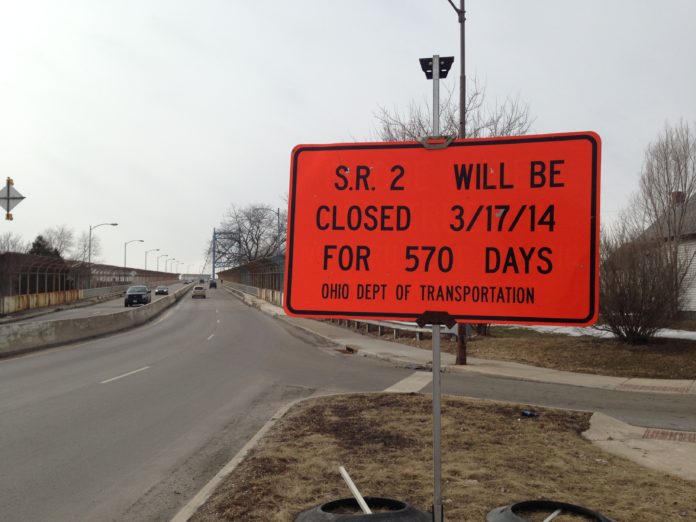One of Toledo’s most iconic landmarks is set to go out of commission for the next 19 months, leaving many area residents and business owners apprehensive yet resigned.
The Anthony Wayne Bridge — more commonly called the High Level Bridge — will close to both vehicles and pedestrians at 7 a.m. March 17 and remain closed until September 2015 as it undergoes repairs. It’s the first longterm closure of this duration in the bridge’s eight-decade history, said Theresa Pollick, public information officer with Ohio Department of Transportation (ODOT), District 2.
Every day, more than 26,000 vehicles cross the 3,215-foot-long span. The structure, which connects Downtown with the city’s East Side over the Maumee River, is the last cable suspension bridge on the state highway system in Ohio, Pollick said.
“Obviously it has historical significance to Toledo,” Pollick said. “When you think of a bridge in Toledo you think of the Anthony Wayne Bridge.”
Compounding the traffic issues will be the Craig Memorial Bridge, which closed Jan. 15 for $11 million in painting and repairs, and, hampered by winter weather delays, will not reopen until March 27.
“We did our best to avoid it, but there will be an overlap,” Pollick said. “We’re working around the clock and squeezing about a third of the contract into a few months. There is a lot of work still to be done there.”
Henry Loughner, a tow truck driver with Boyz Automotive & Towing on East Broadway Street, said he drives across the bridge regularly.
“It’s going to make it a lot harder to get around to this side,” Loughner said. “And the traffic’s going to be crazy because the Craig Street Bridge is already closed out. It’s going to be a little hectic.”
Tim Williams, owner of Big Apple Deli on Woodville Road said he’s hoping for the best.
“You’re obviously nervous about it, but you can’t be upset about something that is progress and is going to improve the condition of the bridge,” he said. “It will make it more difficult for our customers, but our customers are a tough bunch. They come from all over and will get here come heck or high water — we hope anyway.”
Tony Whitaker, a student at Owens Community College, lives on the South End but walks the bridge two to three times a week to visit friends and his girlfriend on the East Side. He said the closure will cut his visits down to once a week unless he can find a ride.
For the past two years, Nicole Strong of South Toledo has been meeting a fellow Fremont Middle School teacher in Northwood to carpool to work. She will discontinue that when the bridge closes.
“It will take way too long to get to her place from mine so we will both just have to drive separate from now on,” Strong said. “I’ve been trying to find another teacher, but there’s nobody I know well enough or feel comfortable enough with carpooling so I’m on my own.”
Jeno DeLuca, owner of Complete Auto Repair on South Summit Street, said he’s afraid he’ll have to switch to a more expensive parts dealer to avoid the trip across the river to his preferred shop. However, he understands the closures.
“Yes, it will affect business,” DeLuca said. “It needs repaired, though. Have you seen it? It’s falling apart.”
Beatriz Garduno, owner of La Cachanilla Mexican Restaurant on South Summit Street near the foot of the bridge, said she’s hoping the closure will actually increase business.
“Last week, we had some construction people working on the bridge who came in and had lunch here,” Garduno said. “I’m hoping it won’t hurt us and might help us a little bit. It’s been a hard winter.”
Danielle Foltz, a cashier at the Valero gas station on the Downtown side of the bridge, said she’s hoping loyal customers and a popular 24-hour Subway will keep the station busy.
“A lot of customers ask about that. We don’t know yet,” Foltz said.
E.S. Wagner Company of Oregon will be the main contractor for the $28.7 million project. The entire concrete bridge deck will be replaced along with sidewalks, railings, street lighting, fencing and expansion joints. The lighting now on the outside sidewalks will move to the median. Substructure work will include repairs to the existing concrete piers and abutments and the addition of two new piers. The bridge will also undergo structural steel repairs to the towers and superstructure.
The most noticeable difference will be the replacement of two steel trusses on each end of the suspension spans with steel girders and the addition of two concrete support pillars, one on each side of the bridge, said Mel Williams, bridge division estimator project manager with E.S. Wagner.
There are 480 locations on the bridge that need steel repaired, including on the towers, the suspension span and the approach span, Williams said.
“A lot of the prep work has been fabricating the repair steel for the superstructure of the bridge,” Williams said. “We have to go in and take out the deteriorated steel, have new steel fabricated and go back and replace the deteriorated.”
Damaged portions of the concrete substructure will also be repaired.
On March 17, workers will begin about two weeks of preliminary work to prepare, Williams said. The next step will be to start taking the deck off the suspension span.
A crew of 50-75 workers will be working on the bridge at any given time, he said.
“It’s a very aggressive schedule to get the amount of work done that has to be done in that time frame,” Williams said. “We’ll work multiple crews and maybe even multiple shifts.”
The Anthony Wayne Bridge was built from 1929-31 for about $3 million.
In 1960-61, the bridge underwent an extensive rehabilitation, including a new deck, tower lighting upgrades and painting. It was repainted in the 1980s. Another major rehabilitation came in 1996-97, including a concrete deck overlay, suspender rope replacement, expansion joint replacement and painting, Pollick said.
Consultants from several companies spent three years, from 2009-12, inspecting the bridge’s structure and cables to determine what repairs were needed. Cables were tested to detect any breaks and the bridge was shut down for a day to take measurements without the weight of traffic.
Starting this fall, safety platforms were installed beneath the bridge.
“We’ve prepared for this one for a long time,” Pollick said. “We spent a long time dedicated to investigating what needed to be done with the bridge because of its age.
“We wanted to keep its historical integrity and do as much preservation work as possible,” she said. “But we had to make these changes to ensure the bridge’s span for the next 50 years.”
Darrel Hafner, owner of Hafner’s Sheet Metal & Supply on South Summit Street, said the bridge is “vital” to the area and it will be interesting to see how things go.
“I would imagine it’s going to be a pain, but I also understand the need and there’s not much you can do about it,” Hafner said. “I’ve been trying to figure it out, but I think I’m better off just adding some gas to the tank and doing my thing. It’s going to be a little bit cumbersome, but I think we can get around it.
“I have about six commercial roofing contractors and 10 residential heating contractors that might have to go out of their way a little bit to get here, but we provide them pretty good service so I’m sure they’ll do it no matter where we’re at. You just gotta work around it and do what you gotta do.”
Oscar Ponce, who owns San Marcos Mexican grocery and restaurant near the bridge, said he’s hoping he won’t lose business when it’s not as convenient for people to get there.
“We are [worried], of course we are,” Ponce said. “We know it’s going to affect our customers, but there’s nothing we can do. People come here because they love our food so hopefully nothing changes. We depend on our customers so I hope everything goes fine.”
Oliver House General Manager Neal Kovacik and Jamie Ondrus of True Value Ondrus Hardware on Oak Street both said there were enough other bridges that they didn’t foresee losing business.
Work is scheduled to be completed by December 2015, but lane restrictions will also be put in place in spring 2016 for painting.
Councilman Mike Craig of District 3 said such closures are just part of the price of living in a city with a river running through it.
“I know there are businesses with concerns,” Craig said. “But you know what the alternative is? Let it go and then close the bridge permanently. ODOT is doing what they have to do to preserve the bridge.”
ODOT’s official eight-mile detour is across the I-75 bridge, but Craig said he’s not so sure people are going to stick to that route.
“Nobody who knows their way around the city is going to take that detour,” Craig said. “I would say probably 80 to 90 percent of traffic is going to detour to the MLK Bridge and that’s going to put a lot of pressure on Main Street.”
Jodi Gross, community builder at East Toledo Family Center, said her biggest concern is traffic cutting across through the neighborhoods and down residential streets.
TARTA has four bus routes that service East Toledo but TARTA actually rerouted its buses over the MLK Bridge in June 2012 in anticipation of this bridge closure as well as Hollywood Casino Toledo opening, said Steve Atkinson, director of marketing for TARTA.
Sgt. Joe Heffernan, public information officer with Toledo Police Department (TPD), said he expects the first 10 days to be the worst because the Craig Bridge will still be closed and because it takes time to adjust to new routes.
TPD will work with traffic engineers on the timing and cycling of lights near the intersection of Front and Main streets in anticipation of heavier traffic. Officers will also be enforcing weight limits for commercial traffic.
“I would just ask for patience,” Heffernan said. “This will work out. People will figure it out as time goes on. It will certainly be an inconvenience in the beginning, but keep your eye on the prize, which is a new refurbished bridge that will serve us for the next 50 years. It will be worth it in the long run.”



